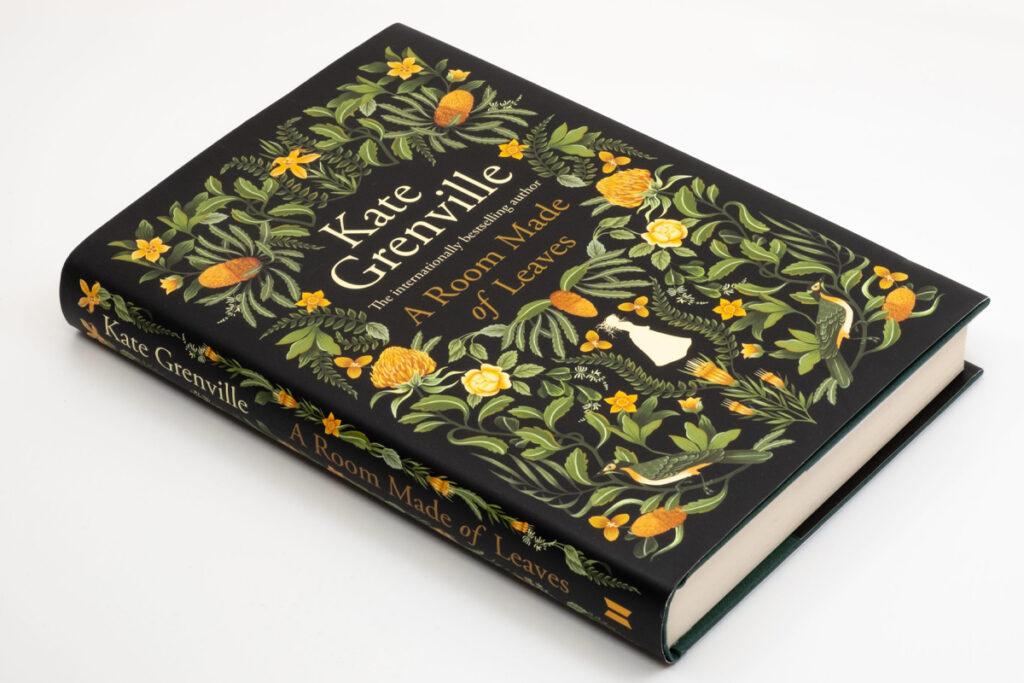If you’ve been joining in with our #ReadingWomen challenge, you’ll have read Kate Grenville’s incredible Women’s Prize for Fiction winner The Idea of Perfection, and you’ll be as excited as we are about Kate’s brand new novel. A Room Made of Leaves publishes this week, and here’s Kate herself on the inspirations and research that went into her beguiling new book.
The idea for A Room Made of Leaves was sparked nearly twenty years ago, when I was doing research for The Secret River, a book set in the earliest years of the British colony in Australia. I came across some of the letters of Elizabeth Macarthur, wife of John Macarthur, a junior officer who arrived with his family in Sydney in 1790.
Australian history, like most histories, is a bit light-on when it comes to women, because they left so little behind. Even when they were educated enough to write letters or journals, those writings are bland, sedate things, suitable to be shared in any genteel parlour. Women at that time had no choice but to be bland. Without any power over any aspect of their lives, they were obliged to go along with a social and legal system that equated them with children. They might have talked together about what they felt about that destiny, but none of them could risk putting it in writing.
Elizabeth Macarthur’s letters are no different. She and John and their infant son landed in a new, raw, violent, hungry penal colony – a thousand convicts and a couple of hundred guards – six months’ sail from home. Yet from her letters – unrevealing, cheery, impersonal – you’d never know any of that.
More interesting to me was what she wrote – or didn’t write – about her husband. The son of a draper, John Macarthur had no prospects other than what he could make for himself, and in Sydney he lost no time in squeezing every drop of advantage out of the place and his position there. His letters – far from bland and sedate – show him to have been a clever, ruthless bully, a dangerous man to cross, violent and unforgiving towards anyone who tried to go against him.
Yet from Elizabeth’s letters there’s not the faintest shadow of any of that. Reading her letters, you’d think he was a kindly, cheerful, reasonable man beloved of all around him. Either he was a completely different man at home, or her letters are beautiful lies.
Enter William Dawes, another junior officer in the Sydney of 1790. Dawes emerges from the record as a very likeable man: warm, selfless, with great integrity. He was the colony’s resident astronomer and Elizabeth Macarthur asked him for lessons in “a few easy stars”. However, stars turned out not to be as easy as she thought and, she says, “I mistook my abilities, and I blush at my error.”

I blush at my error! In the context of her otherwise bloodless letters, those five words blaze off the page with an unmistakable erotic charge. Suddenly – for the only time in all the many pages she wrote – she’s a flesh-and-blood woman. What might have happened after Mrs Macarthur blushed?
Those five words are where this book started. What they told me was that she wasn’t as bland and boring as her letters might suggest. She lived – or at least wrote – behind a mask, and just for that one instant, the mask slipped.
A body of myth has grown around Elizabeth and John Macarthur. Generations of schoolchildren have learned that John Macarthur more or less singlehandedly bred the Australian Merino sheep that until recently was the basis of our economy. All over Australia, streets and schools are named in his honour. The myth about Elizabeth is that, when John was away in England for two long periods, she kept the family sheep empire going, a loving, industrious, pious helpmeet to her husband.
The slipping of the mask gave me a way to sneak in behind the myth and explore something more interesting, and possibly more true. The way I put it to myself was that Elizabeth Macarthur had written the fictional account of her life, in those bland letters. I was going to write the non-fictional account, the truth that she couldn’t ever risk putting on paper. It would take the form of her secret memoirs, hidden in a tin box tucked away in the roof of her house. I’d pretend that I’d found these memoirs, and that I was simply transcribing and publishing them. The joke-within-a-joke would be that the story would be based on the real documentary record, and would even include quotes from Elizabeth Macarthur’s real letters. Fact and fiction would overlap and allow a fictional woman of the past to do what would have been impossible for any real woman of that time: to put down in writing what she really thought.
It was an exciting project to try to give Elizabeth Macarthur the voice she could never have had. She was a remarkable woman, to have managed the gigantic enterprise of the family business at a time when women were expected to be helpless and ignorant and stay at home with the children. She was on her own – for four years during her husband’s first absence, nine years the second – in a brutal society, yet she came to thrive. By the time Macarthur came back from that second absence, he was overwhelmed by mental illness, but the business his wife had managed so well was the richest in the colony.
But as I wrote, I realised that this was more than a book about an extraordinary woman. It was about the dangerous power of false stories, false surfaces, myths, and they way they can erase the truth. Women were not the only people whose voices were silenced. In the Australian context, the other great silencing concerns the story of the Aboriginal people. The accounts left by those early settlers are the only written accounts of that history, but as Elizabeth Macarthur warns us, Do not believe too quickly!
I travelled to Devon to research Elizabeth’s childhood, and spent many hours at Elizabeth Farm and other locations around Parramatta. I drew on as many primary sources as I could find: the parish records of Bridgerule in Devon, archives in the State Library of NSW, Governors’ correspondence, and contemporary accounts of early Sydney. A Room Made of Leaves had found its form and content by the time Michelle Scott Tucker’s biography of Elizabeth Macarthur was published, and I didn’t draw on that book in writing my own, but Michelle was helpful in advising me how to contact Macarthur descendants to let them know of the book (which I did as a courtesy to them). My reading of the primary sources has sometimes led me in a different direction from other writers about Elizabeth Macarthur. But what I think we all share is admiration for that remarkable woman.
This book isn’t history. It’s fiction. But, like most historical fiction, it starts in the same place history does: in the record of the past left to us in documents, oral traditions, buildings, landscapes and objects. Historians devise one kind of story from those sources. Fiction writers devise another kind. Those sources are flawed, partial and ambiguous. For that reason, the stories that come out of them, although starting in the same place, can end up very differently. But what historians and writers of historical fiction have in common is an urge to understand that past: what it meant then, and perhaps more importantly, what it means now: for us, living in the world that’s been shaped by that past.


